1. Watch this video
2a. Study this summary
1. What Are Sex-Linked Genes?
Sex-linked genes are located on the X chromosome. Males, having only one X chromosome, cannot be heterozygous—they either inherit the allele for a trait or they do not. This means that the traditional concepts of homozygous and heterozygous do not apply to males for X-linked traits. In contrast, females, who have two X chromosomes, can be homozygous dominant (e.g., XHXH), homozygous recessive (e.g., XhXh), or heterozygous (e.g., XHXh). Heterozygous females are commonly referred to as carriers for recessive X-linked traits.
2. Hemophilia as an Example of X-Linked Inheritance
Hemophilia is a blood-clotting disorder caused by a recessive allele on the X chromosome. This condition is significantly more common in males than females because males inherit their single X chromosome from their mothers. Fathers contribute a Y chromosome to their sons, determining their male sex but not influencing X-linked traits.
For a male to inherit hemophilia, his mother must carry the hemophilia allele (XHXh). Rarely, a mother might be homozygous recessive (XhXh). A Punnett square demonstrates how this inheritance works, showing that sons of carrier mothers have a 50% chance of inheriting the condition, depending on whether they inherit the X chromosome with the hemophilia allele or the normal X chromosome.
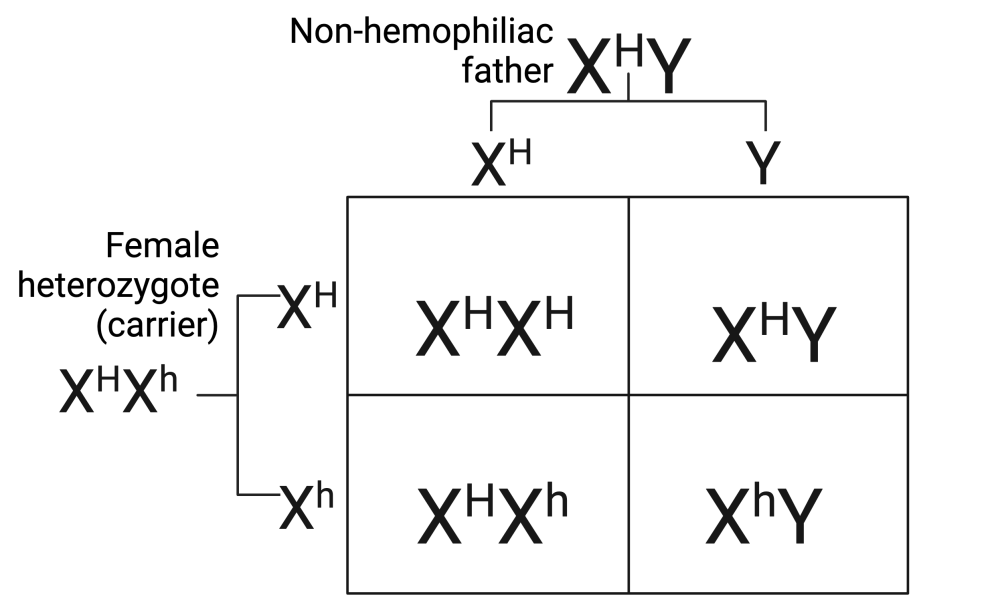
3. Pedigrees and X-Linked Inheritance Patterns
Pedigrees illustrate how traits pass through families. Here’s a pedigree for hemophilia.
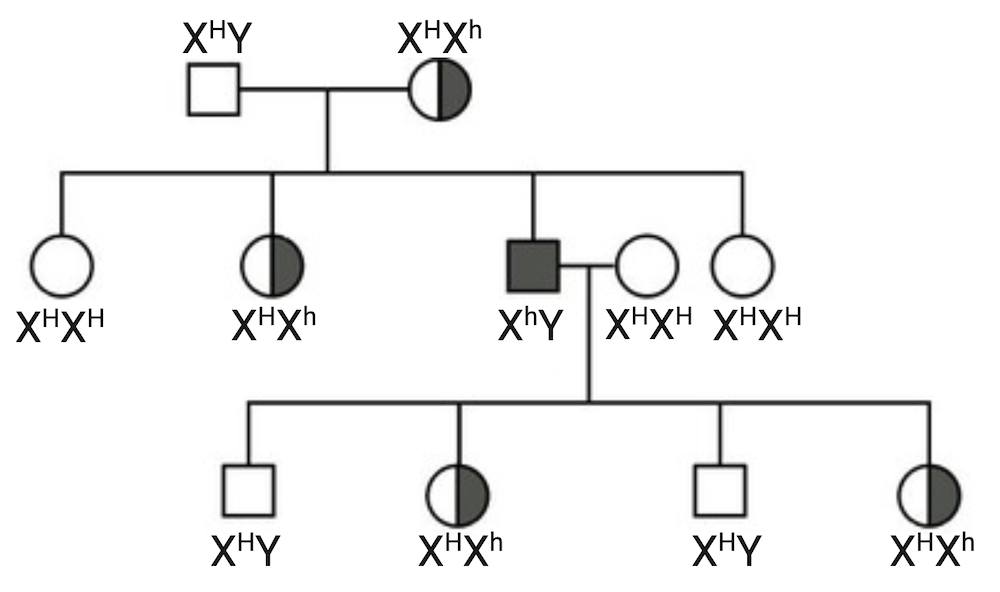
Note the key patterns (which apply to all sex-linked conditions)
- Males inherit the condition more often than females.
- The fathers of affected males are themselves unaffected (because the affected male inherits the condition from his mother, who is either a heterozygote (as shown above) or homozygous recessive (not shown in the pedigree above).
4. Other Examples of X-Linked Traits
Beyond hemophilia, red-green color blindness is a common X-linked recessive condition in humans. In fruit flies (Drosophila melanogaster), white eyes are caused by an X-linked mutation. The discovery of the white-eye gene in fruit flies was a significant moment in the history of genetics, as it marked the first time a gene was linked to a specific chromosome, laying the groundwork for modern genetics.
5. Female Inheritance of X-Linked Traits
Although uncommon, females can inherit X-linked recessive traits under specific conditions:
- The father must have the condition (e.g., XWY for white eyes in fruit flies).
- The mother must be a carrier (e.g., XWXw) or also have the condition (e.g., XwXw).
A Punnett square for this scenario reveals that:
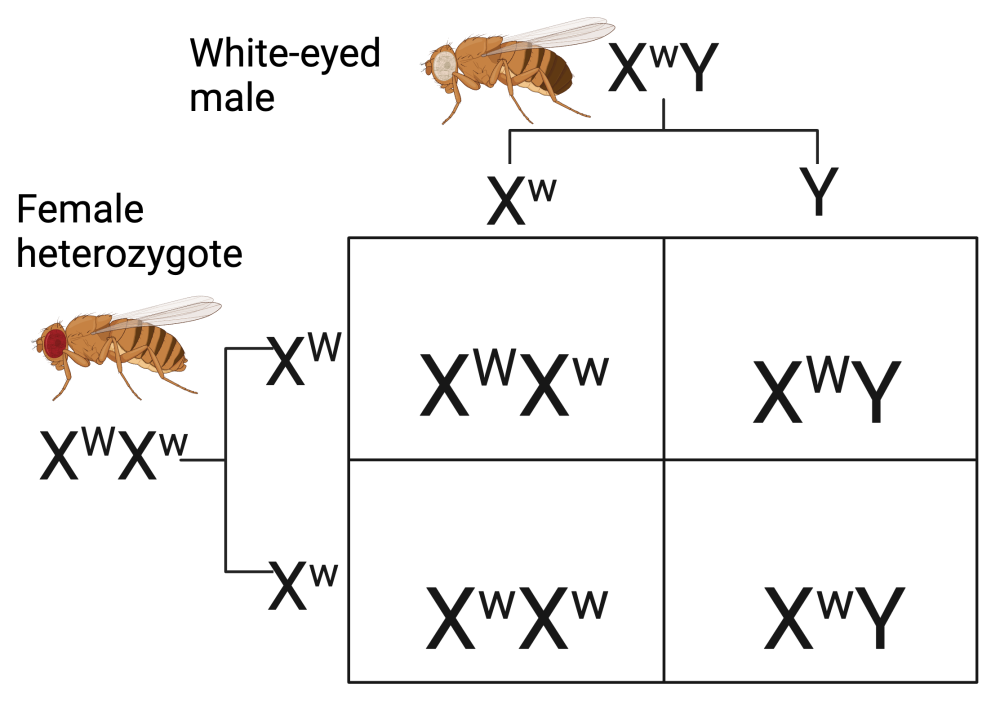
- 50% of female offspring are carriers (XWXw).
- 50% of female offspring inherit the condition (XwXw).
- Among male offspring, 50% are normal (XWY), and 50% inherit the condition (XwY).
3. Master these flashcards
[qdeck qrecord_id=”sciencemusicvideosMeister1961-Sex Linked Genes, APBVP”]
[h]Sex-Linked Genes
[q]What are sex-linked genes?
[a]Sex-linked genes are located on the X chromosome. Males cannot be heterozygous for these traits, while females can be homozygous or heterozygous.
[q]Why can’t males be heterozygous for sex-linked traits?
[a]Males only have one X chromosome, so they either inherit the allele for a trait or they do not. The concepts of homozygous and heterozygous do not apply to males.
[q]What is hemophilia?
[a]Hemophilia is a blood-clotting disorder caused by a recessive allele on the X chromosome.
[q]Using the alleles for normal blood clotting (H) and hemophilia (h) what are the possible genotypes for females? Remember that the condition is sex-linked.
[a]Females can be homozygous dominant (e.g., XHXH), homozygous recessive (e.g., XhXh), or heterozygous (e.g., XHXh).
[q]How do males inherit hemophilia?
[a]Males inherit hemophilia if their mother carries the recessive allele for the condition (XHXh or, rarely, XhXh). Fathers do not contribute an X chromosome to their sons.
[q]What are the chances of a son inheriting hemophilia from a carrier mother?
[a]A son has a 50% chance of inheriting hemophilia from a carrier mother, whose genotype is XHXh. That’s because there’s a 50% chance of him inheriting XH, and a 50% of inheriting Xh.
[q]In a cross for hemophilia, what is the typical outcome for children of a heterozygous mother and an unaffected father?
[a]Sons have a 50% chance of being hemophiliacs, while daughters have a 50% chance of being carriers.
[q]Besides hemophilia, what’s a somewhat common example of an X-linked recessive conditions in humans?
[a]Red-green color blindness.
[q]What are the chances of a female inheriting an X-linked recessive condition from a carrier mother and an affected father?
[a]50% of female offspring will inherit the condition, while 50% will be carriers.
[q]How can a female inherit an X-linked recessive condition?
[a]A female inherits the condition if her father has the condition, and her mother is a carrier or also has the condition.
[x][restart]
[/qdeck]
4. Tackle these quizzes
4.1.Understanding Hemophilia (A sex-linked trait)
[qwiz style=”width: 650px; min-height: 0px; border: 2px solid black;” qrecord_id=”sciencemusicvideosMeister1961-Understanding Hemophilia (A Sex-Linked trait), APBVP”]
[h]Understanding Hemophilia (A Sex-Linked trait)
[q multiple_choice=”true”]A man with hemophilia must have inherited his hemophilia allele from
[c]aGlzIG1v dGhlcg==[Qq]
[f]VGhhdCYjODIxNztzIGNvcnJlY3QuIEEgbWFuIHdpdGggaGVtb3BoaWxpYSBoYXMgdG8gaW5oZXJpdCB0aGUgYWxsZWxlIGZyb20gaGlzIG1vdGhlci4gVGhhdCYjODIxNztzIGJlY2F1c2UgdGhlIGFsbGVsZSBpcyBvbiB0aGUgWCBjaHJvbW9zb21lLCBhbmQgYSBtYW4gY2FuIG9ubHkgaW5oZXJpdCBhbiBYIGNocm9tb3NvbWUgdGhyb3VnaCBoaXMgbW90aGVyJiM4MjE3O3MgZWdnLg==
Cg==[Qq]
[c]aGlzIGZhdGhlcg==[Qq]
[f]Tm8uIEEgbWFuIGluaGVyaXRzIGhpcyBYIGNocm9tb3NvbWUgZnJvbSBoaXMgbW90aGVyIGFuZCBoaXMgWSBjaHJvbW9zb21lIGZyb20gaGlzIGZhdGhlciAod2hpY2ggaXMgd2h5IGhlJiM4MjE3O3MgYSBtYW4pLiBTaW5jZSB0aGUgaGVtb3BoaWxpYSBhbGxlbGUgaXMgb24gdGhlIFggY2hyb21vc29tZSwgYSBtYW4gd2l0aCBoZW1vcGhpbGlhIG11c3QgaW5oZXJpdCB0aGUgYWxsZWxlIGZyb20gaGlzIG1vdGhlciYjODIxNztzIFggY2hyb21vc29tZS4=
Cg==[Qq]
[c]ZWl0aGVyIHBhcmVudA==[Qq]
[f]Tm8uIEEgbWFuIGluaGVyaXRzIGhpcyBYIGNocm9tb3NvbWUgZnJvbSBoaXMgbW90aGVyIGFuZCBoaXMgWSBjaHJvbW9zb21lIGZyb20gaGlzIGZhdGhlciAod2hpY2ggaXMgd2h5IGhlJiM4MjE3O3MgYSBtYW4pLiBTaW5jZSB0aGUgaGVtb3BoaWxpYSBhbGxlbGUgaXMgb24gdGhlIFggY2hyb21vc29tZSwgYSBtYW4gd2l0aCBoZW1vcGhpbGlhIG11c3QgaW5oZXJpdCB0aGUgYWxsZWxlIGZyb20gaGlzIG1vdGhlciYjODIxNztzIFggY2hyb21vc29tZS4=
Cg==[Qq]
[q multiple-choice=”true”]The X chromosome contains many alleles that are not found on the Y chromosome.
[c]dHJ1 ZQ==[Qq]
[f]WWVzLiBUaGUgWCBjaHJvbW9zb21lIGhhcyBodW5kcmVkcyBvZiBhbGxlbGVzIHRoYXQgYXJlIG5vdCBmb3VuZCBvbiB0aGUgWSBjaHJvbW9zb21lLg==[Qq]
[c]ZmFsc2U=[Qq]
[f]Tm8uIEhlcmUmIzgyMTc7cyBhIGhpbnQ6IHRha2UgYSBsb29rIGF0IHRoaXMgY2hyb21vc29tZSBtYXAu
Cg==[Qq]
[c]SXQgZGVwZW5kcyBvbiB3aGV0aGVyIHRoZSBYIGNocm9tb3NvbWUgaXMgaW5oZXJpdGVkIGZyb20gdGhlIG1vdGhlciBvciB0aGUgZmF0aGVyLg==[Qq]
[f]Tm8uIFRoZSBYIGNocm9tb3NvbWUmIzgyMTc7cyBzaXplIGFuZCBpbmZvcm1hdGlvbiBoYXZlIG5vdGhpbmcgdG8gZG8gd2l0aCB3aGljaCBwYXJlbnQgaXQmIzgyMTc7cyBpbmhlcml0ZWQgZnJvbS4=
Cg==SGVyZSYjODIxNztzIGEgaGludDogdGFrZSBhIGxvb2sgYXQgdGhpcyBjaHJvbW9zb21lIG1hcC4=
Cg==[Qq]
[q]Complete the table below.
| Description | Genotype |
| Normal male | ___ ___ |
| Hemophiliac male | ___ ___ |
| Homozygous Normal Female | ___ ___ |
| Heterozygous Normal female | ___ ___ |
| Hemophiliac Female | ___ ___ |
[l]XH
[fx] No, that’s not correct. Please try again.
[f*] Great!
[l]Xh
[fx] No, that’s not correct. Please try again.
[f*] Correct!
[l]Y
[fx] No, that’s not correct. Please try again.
[f*] Great!
[q]When genes like the one for hemophilia are on the X-chromosome, they’re called X-linked or [hangman]-linked.
[c]c2V4[Qq]
[q labels = “top”]
[l]XHY
[fx] No. Please try again.
[f*] Excellent!
[l]XhY
[fx] No. Please try again.
[f*] Good!
[l]XHXH
[fx] No, that’s not correct. Please try again.
[f*] Correct!
[l]XHXh
[fx] No, that’s not correct. Please try again.
[f*] Good!
[l]XhXh
[fx] No, that’s not correct. Please try again.
[f*] Excellent!
[/qwiz]
4.2. Solving Sex-Linked Problems
[qwiz qrecord_id=”sciencemusicvideosMeister1961-Sex Linkage: Interactive Punnett Square, APBVP”]
[h]Sex Linkage: Interactive Punnett Square
[q]A woman who is a carrier for hemophilia (she has the allele but not the trait) has children with a normal (non-hemophiliac) man. What will be the genotypes and phenotypes of their offspring?
Genotypes of the parents
Mother: ___ ___
Father: ___ ___
| Father | |||
| ___ | ___ | ||
| Mother | ___ | ___ ___ | ___ ___ |
| ___ | ___ ___ | ___ ___ | |
Genotype ratio:
_____XHY: ____XhY: _____XHXH: ___XHXh:_____XhXh
Phenotype ratio:
_____ Hemophiliac man
_____ Normal blood-clotting man:
_____ Homozygous normal woman
_____ Carrier (heterozygous) woman
_____ Hemophiliac woman
[l]XH
[fx] No. Please try again.
[f*] Excellent!
[l]Y
[fx] No, that’s not correct. Please try again.
[f*] Good!
[l]Xh
[fx] No. Please try again.
[f*] Great!
[l]0%
[fx] No. Please try again.
[f*] Good!
[l]25%
[fx] No. Please try again.
[f*] Excellent!
[l]50%
[fx] No, that’s not correct. Please try again.
[f*] Correct!
[l]75%
[fx] No. Please try again.
[f*] Good!
[l]100%
[fx] No. Please try again.
[f*] Correct!
[q json=”true” xyz=”2″ multiple_choice=”true” unit=”5.Heredity” dataset_id=”2019 AP Bio Dataset|228ab0e4bc8c5a” question_number=”235″ topic=”5.4.Non-Mendelian_Genetics”] The pedigree below shows inheritance of an X-linked recessive trait.
What is the probability that the female designated as “1″ is a carrier for the trait?
[c]IDAlIA==[Qq][c]IDI1JSA=[Qq][c]IDUw JSA=[Qq][c]IDc1JSA=[Qq][c]IDEwMCU=
Cg==[Qq][f]IE5vLiBIZXJlJiM4MjE3O3MgaG93IHRvIHRoaW5rIGFib3V0IHRoaXMgcXVlc3Rpb24uIEltYWdpbmUgdGhhdCB0aGlzIGlzIGFib3V0IGFueSBvZiB0aGUgcmVjZXNzaXZlLCBzZXgtbGlua2VkIHRyYWl0cyB0aGF0IHlvdSYjODIxNzt2ZSBsZWFybmVkIGFib3V0IHRoaXMgeWVhciwgc3VjaCBhcyBoZW1vcGhpbGlhLiBGb3IgY2xhcml0eSwgbGV0JiM4MjE3O3MgaGF2ZSAmIzgyMjA7SCYjODIyMTsgc3RhbmQgZm9yIHRoZSBub3JtYWwgYWxsZWxlIGFuZCAmIzgyMjA7aCYjODIyMTsgZm9yIHRoZSBhbGxlbGUgdGhhdCBjYXVzZXMgdGhlIHJlY2Vzc2l2ZSBjb25kaXRpb24uIEJlY2F1c2UgdGhlIGZlbWFsZSBhdCAxIGhhcyBhIGJyb3RoZXIgd2hvIGhhcyB0aGUgY29uZGl0aW9uLCBhbmQgcGFyZW50cyB3aG8gZG9uJiM4MjE3O3QgaGF2ZSB0aGUgY29uZGl0aW9uIHRoZW4gd2Uga25vdyB0aGF0IHRoZSBtb3RoZXIgb2YgMSBpcyBhIGNhcnJpZXIgKFg=SA==WA==aA==KSwgYW5kIHRoZSBmYXRoZXIgd2FzIG5vcm1hbCAoWA==[Qq]HY).
If you can, your best move at this point is to make a Punnett square and figure out the answer. If you need to see the Punnett square that I made to solve this problem, read on…
Here’s the Punnett square:
| XH | Xh | |
| XH | XHXH | XHXh |
| Y | XHY | XhY |
Look at the two girls in the top row, and you should be able to figure out the probability that any one of the daughters will be a carrier.
[f]IE5vLiBIZXJlJiM4MjE3O3MgaG93IHRvIHRoaW5rIGFib3V0IHRoaXMgcXVlc3Rpb24uIEltYWdpbmUgdGhhdCB0aGlzIGlzIGFib3V0IGFueSBvZiB0aGUgcmVjZXNzaXZlLCBzZXgtbGlua2VkIHRyYWl0cyB0aGF0IHlvdSYjODIxNzt2ZSBsZWFybmVkIGFib3V0IHRoaXMgeWVhciwgc3VjaCBhcyBoZW1vcGhpbGlhLiBGb3IgY2xhcml0eSwgbGV0JiM4MjE3O3MgaGF2ZSAmIzgyMjA7SCYjODIyMTsgc3RhbmQgZm9yIHRoZSBub3JtYWwgYWxsZWxlIGFuZCAmIzgyMjA7aCYjODIyMTsgZm9yIHRoZSBhbGxlbGUgdGhhdCBjYXVzZXMgdGhlIHJlY2Vzc2l2ZSBjb25kaXRpb24uIEJlY2F1c2UgdGhlIGZlbWFsZSBhdCAxIGhhcyBhIGJyb3RoZXIgd2hvIGhhcyB0aGUgY29uZGl0aW9uLCBhbmQgcGFyZW50cyB3aG8gZG9uJiM4MjE3O3QgaGF2ZSB0aGUgY29uZGl0aW9uIHRoZW4gd2Uga25vdyB0aGF0IHRoZSBtb3RoZXIgb2YgMSBpcyBhIGNhcnJpZXIgKFg=SA==WA==aA==KSwgYW5kIHRoZSBmYXRoZXIgd2FzIG5vcm1hbCAoWA==[Qq]HY).
If you can, your best move at this point is to make a Punnett square and figure out the answer. If you need to see the Punnett square that I made to solve this problem, read on…
Here’s the Punnett square:
| XH | Xh | |
| XH | XHXH | XHXh |
| Y | XHY | XhY |
Look at the two girls in the top row, and you should be able to figure out the probability that any one of the daughters will be a carrier.
[f]IEV4Y2VsbGVudCEgVGhlIHByb2JhYmlsaXR5IHRoYXQgaW5kaXZpZHVhbCAxIChvbmUgb2YgdGhlIGRhdWdodGVycykgaXMgYSBjYXJyaWVyIGlzIDUwJSwgYXMgeW91IGNhbiBzZWUgYnkgdGhpcyBQdW5uZXR0IHNxdWFyZQ==
Cg==| [Qq] | XH | Xh |
| XH | XHXH | XHXh |
| Y | XHY | XhY |
[f]IE5vLiBIZXJlJiM4MjE3O3MgaG93IHRvIHRoaW5rIGFib3V0IHRoaXMgcXVlc3Rpb24uIEltYWdpbmUgdGhhdCB0aGlzIGlzIGFib3V0IGFueSBvZiB0aGUgcmVjZXNzaXZlLCBzZXgtbGlua2VkIHRyYWl0cyB0aGF0IHlvdSYjODIxNzt2ZSBsZWFybmVkIGFib3V0IHRoaXMgeWVhciwgc3VjaCBhcyBoZW1vcGhpbGlhLiBGb3IgY2xhcml0eSwgbGV0JiM4MjE3O3MgaGF2ZSAmIzgyMjA7SCYjODIyMTsgc3RhbmQgZm9yIHRoZSBub3JtYWwgYWxsZWxlIGFuZCAmIzgyMjA7aCYjODIyMTsgZm9yIHRoZSBhbGxlbGUgdGhhdCBjYXVzZXMgdGhlIHJlY2Vzc2l2ZSBjb25kaXRpb24uIEJlY2F1c2UgdGhlIGZlbWFsZSBhdCAxIGhhcyBhIGJyb3RoZXIgd2hvIGhhcyB0aGUgY29uZGl0aW9uLCBhbmQgcGFyZW50cyB3aG8gZG9uJiM4MjE3O3QgaGF2ZSB0aGUgY29uZGl0aW9uIHRoZW4gd2Uga25vdyB0aGF0IHRoZSBtb3RoZXIgb2YgMSBpcyBhIGNhcnJpZXIgKFg=SA==WA==aA==KSwgYW5kIHRoZSBmYXRoZXIgd2FzIG5vcm1hbCAoWA==[Qq]HY).
If you can, your best move at this point is to make a Punnett square and figure out the answer. If you need to see the Punnett square that I made to solve this problem, read on…
Here’s the Punnett square:
| XH | Xh | |
| XH | XHXH | XHXh |
| Y | XHY | XhY |
Look at the two girls in the top row, and you should be able to figure out the probability that any one of the daughters will be a carrier.
[f]IE5vLiBIZXJlJiM4MjE3O3MgaG93IHRvIHRoaW5rIGFib3V0IHRoaXMgcXVlc3Rpb24uIEltYWdpbmUgdGhhdCB0aGlzIGlzIGFib3V0IGFueSBvZiB0aGUgcmVjZXNzaXZlLCBzZXgtbGlua2VkIHRyYWl0cyB0aGF0IHlvdSYjODIxNzt2ZSBsZWFybmVkIGFib3V0IHRoaXMgeWVhciwgc3VjaCBhcyBoZW1vcGhpbGlhLiBGb3IgY2xhcml0eSwgbGV0JiM4MjE3O3MgaGF2ZSAmIzgyMjA7SCYjODIyMTsgc3RhbmQgZm9yIHRoZSBub3JtYWwgYWxsZWxlIGFuZCAmIzgyMjA7aCYjODIyMTsgZm9yIHRoZSBhbGxlbGUgdGhhdCBjYXVzZXMgdGhlIHJlY2Vzc2l2ZSBjb25kaXRpb24uIEJlY2F1c2UgdGhlIGZlbWFsZSBhdCAxIGhhcyBhIGJyb3RoZXIgd2hvIGhhcyB0aGUgY29uZGl0aW9uLCBhbmQgcGFyZW50cyB3aG8gZG9uJiM4MjE3O3QgaGF2ZSB0aGUgY29uZGl0aW9uIHRoZW4gd2Uga25vdyB0aGF0IHRoZSBtb3RoZXIgb2YgMSBpcyBhIGNhcnJpZXIgKFg=SA==WA==aA==KSwgYW5kIHRoZSBmYXRoZXIgd2FzIG5vcm1hbCAoWA==[Qq]HY).
If you can, your best move at this point is to make a Punnett square and figure out the answer. If you need to see the Punnett square that I made to solve this problem, read on…
Here’s the Punnett square:
| XH | Xh | |
| XH | XHXH | XHXh |
| Y | XHY | XhY |
Look at the two girls in the top row, and you should be able to figure out the probability that any one of the daughters will be a carrier.
[q json=”true” xyz=”2″ multiple_choice=”true” unit=”5.Heredity” dataset_id=”2019 AP Bio Dataset|228394286a145a” question_number=”233″ topic=”5.3.Mendelian_Genetics”] The pedigree below shows the inheritance of an X-linked recessive trait.
If the child indicated by ? is a girl, what is the probability she will be affected by the trait?
[c]IDAlIA==[Qq][c]IDI1 JSA=[Qq][c]IDUwJSA=[Qq][c]IDc1JSA=[Qq][c]IDEwMCU=
Cg==[Qq][f]IE5vLiBIZXJlJiM4MjE3O3MgaG93IHRvIHRoaW5rIGFib3V0IHRoaXMgcXVlc3Rpb24uIEltYWdpbmUgdGhhdCB0aGUgdHJhaXQgdW5kZXIgZGlzY3Vzc2lvbiBpcyBoZW1vcGhpbGlhLiBGb3IgY2xhcml0eSwgbGV0JiM4MjE3O3MgaGF2ZSAmIzgyMjA7SCYjODIyMTsgc3RhbmQgZm9yIHRoZSBub3JtYWwgYWxsZWxlIGFuZCAmIzgyMjA7aCYjODIyMTsgZm9yIHRoZSBhbGxlbGUgdGhhdCBjYXVzZXMgdGhlIHJlY2Vzc2l2ZSBjb25kaXRpb24uIFRoZSBjaGlsZCBhdCA=Pw==IGhhcyBhIGZhdGhlciB3aG8gaGFzIHRoZSB0cmFpdDogdGhlcmVmb3JlIHRoZSBmYXRoZXImIzgyMTc7cyBnZW5vdHlwZSBpcyBYaA==WS4gVGhlIGNoaWxkJiM4MjE3O3MgbW90aGVyIGhhZCBhIGJyb3RoZXIgd2hvIGhhZCB0aGUgcmVjZXNzaXZlIHRyYWl0LiBUaGVyZWZvcmUgPyYjODIxNztzIGdyYW5kbW90aGVyIGhhZCB0byBiZSBhIGNhcnJpZXIsIGFuZCA/JiM4MjE3O3MgbW90aGVyIGhhcyBhIDUwJSBjaGFuY2Ugb2YgYmVpbmcgYSBjYXJyaWVyLg==
[Qq]Now use the rule of multiplication. It’s already established in the question that the child is a girl. There’s a 100% chance that she’ll inherit the recessive allele from her father (that’s how she wound up being a girl in the first place, right?) There’s a 1/2 chance that the mother is a carrier. And, if mom’s a carrier, there’s a 1/2 chance that she’ll pass on her Xh allele, producing a daughter that’s XhXh. Multiply these probabilities out, and you’ll have your answer.
[f]IEV4Y2VsbGVudCEgSXQmIzgyMTc7cyBhbHJlYWR5IGVzdGFibGlzaGVkIGluIHRoZSBxdWVzdGlvbiB0aGF0IHRoZSBjaGlsZCBpcyBhIGdpcmwuIFRoZXJlJiM4MjE3O3MgYSAxMDAlIGNoYW5jZSB0aGF0IHNoZSYjODIxNztsbCBpbmhlcml0IHRoZSByZWNlc3NpdmUgYWxsZWxlIGZyb20gaGVyIGZhdGhlciAodGhhdCYjODIxNztzIGhvdyBzaGUgd291bmQgdXAgYmVpbmcgYSBnaXJsIGluIHRoZSBmaXJzdCBwbGFjZSwgcmlnaHQ/KSBUaGVyZSYjODIxNztzIGEgMS8yIGNoYW5jZSB0aGF0IHRoZSBtb3RoZXIgaXMgYSBjYXJyaWVyLiBBbmQsIGlmIG1vbSYjODIxNztzIGEgY2FycmllciwgdGhlcmUmIzgyMTc7cyBhIDEvMiBjaGFuY2UgdGhhdCBzaGUmIzgyMTc7bGwgcGFzcyBvbiBoZXIgWA==aA==IGFsbGVsZSwgcHJvZHVjaW5nIGEgZGF1Z2h0ZXIgdGhhdCYjODIxNztzIFg=aA==WA==[Qq]h. 1/2 x 1/2 = 1/4.
[f]IE5vLiBIZXJlJiM4MjE3O3MgaG93IHRvIHRoaW5rIGFib3V0IHRoaXMgcXVlc3Rpb24uIEltYWdpbmUgdGhhdCB0aGUgdHJhaXQgdW5kZXIgZGlzY3Vzc2lvbiBpcyBoZW1vcGhpbGlhLiBGb3IgY2xhcml0eSwgbGV0JiM4MjE3O3MgaGF2ZSAmIzgyMjA7SCYjODIyMTsgc3RhbmQgZm9yIHRoZSBub3JtYWwgYWxsZWxlIGFuZCAmIzgyMjA7aCYjODIyMTsgZm9yIHRoZSBhbGxlbGUgdGhhdCBjYXVzZXMgdGhlIHJlY2Vzc2l2ZSBjb25kaXRpb24uIFRoZSBjaGlsZCBhdCA=Pw==IGhhcyBhIGZhdGhlciB3aG8gaGFzIHRoZSB0cmFpdDogdGhlcmVmb3JlIHRoZSBmYXRoZXImIzgyMTc7cyBnZW5vdHlwZSBpcyBYaA==WS4gVGhlIGNoaWxkJiM4MjE3O3MgbW90aGVyIGhhZCBhIGJyb3RoZXIgd2hvIGhhZCB0aGUgcmVjZXNzaXZlIHRyYWl0LiBUaGVyZWZvcmUgPyYjODIxNztzIGdyYW5kbW90aGVyIGhhZCB0byBiZSBhIGNhcnJpZXIsIGFuZCA/JiM4MjE3O3MgbW90aGVyIGhhcyBhIDUwJSBjaGFuY2Ugb2YgYmVpbmcgYSBjYXJyaWVyLg==
[Qq]Now use the rule of multiplication. It’s already established in the question that the child is a girl. There’s a 100% chance that she’ll inherit the recessive allele from her father (that’s how she wound up being a girl in the first place, right?) There’s a 1/2 chance that the mother is a carrier. And, if mom’s a carrier, there’s a 1/2 chance that she’ll pass on her Xh allele, producing a daughter that’s XhXh. Multiply these probabilities out, and you’ll have your answer.
[f]IE5vLiBIZXJlJiM4MjE3O3MgaG93IHRvIHRoaW5rIGFib3V0IHRoaXMgcXVlc3Rpb24uIEltYWdpbmUgdGhhdCB0aGUgdHJhaXQgdW5kZXIgZGlzY3Vzc2lvbiBpcyBoZW1vcGhpbGlhLiBGb3IgY2xhcml0eSwgbGV0JiM4MjE3O3MgaGF2ZSAmIzgyMjA7SCYjODIyMTsgc3RhbmQgZm9yIHRoZSBub3JtYWwgYWxsZWxlIGFuZCAmIzgyMjA7aCYjODIyMTsgZm9yIHRoZSBhbGxlbGUgdGhhdCBjYXVzZXMgdGhlIHJlY2Vzc2l2ZSBjb25kaXRpb24uIFRoZSBjaGlsZCBhdCA=Pw==IGhhcyBhIGZhdGhlciB3aG8gaGFzIHRoZSB0cmFpdDogdGhlcmVmb3JlIHRoZSBmYXRoZXImIzgyMTc7cyBnZW5vdHlwZSBpcyBYaA==WS4gVGhlIGNoaWxkJiM4MjE3O3MgbW90aGVyIGhhZCBhIGJyb3RoZXIgd2hvIGhhZCB0aGUgcmVjZXNzaXZlIHRyYWl0LiBUaGVyZWZvcmUgPyYjODIxNztzIGdyYW5kbW90aGVyIGhhZCB0byBiZSBhIGNhcnJpZXIsIGFuZCA/JiM4MjE3O3MgbW90aGVyIGhhcyBhIDUwJSBjaGFuY2Ugb2YgYmVpbmcgYSBjYXJyaWVyLg==
[Qq]Now use the rule of multiplication. It’s already established in the question that the child is a girl. There’s a 100% chance that she’ll inherit the recessive allele from her father (that’s how she wound up being a girl in the first place, right?) There’s a 1/2 chance that the mother is a carrier. And, if mom’s a carrier, there’s a 1/2 chance that she’ll pass on her Xh allele, producing a daughter that’s XhXh. Multiply these probabilities out, and you’ll have your answer.
[f]IE5vLiBIZXJlJiM4MjE3O3MgaG93IHRvIHRoaW5rIGFib3V0IHRoaXMgcXVlc3Rpb24uIEltYWdpbmUgdGhhdCB0aGUgdHJhaXQgdW5kZXIgZGlzY3Vzc2lvbiBpcyBoZW1vcGhpbGlhLiBGb3IgY2xhcml0eSwgbGV0JiM4MjE3O3MgaGF2ZSAmIzgyMjA7SCYjODIyMTsgc3RhbmQgZm9yIHRoZSBub3JtYWwgYWxsZWxlIGFuZCAmIzgyMjA7aCYjODIyMTsgZm9yIHRoZSBhbGxlbGUgdGhhdCBjYXVzZXMgdGhlIHJlY2Vzc2l2ZSBjb25kaXRpb24uIFRoZSBjaGlsZCBhdCA=Pw==IGhhcyBhIGZhdGhlciB3aG8gaGFzIHRoZSB0cmFpdDogdGhlcmVmb3JlIHRoZSBmYXRoZXImIzgyMTc7cyBnZW5vdHlwZSBpcyBYaA==WS4gVGhlIGNoaWxkJiM4MjE3O3MgbW90aGVyIGhhZCBhIGJyb3RoZXIgd2hvIGhhcyB0aGUgcmVjZXNzaXZlIHRyYWl0LiBUaGVyZWZvcmUgPyYjODIxNztzIGdyYW5kbW90aGVyIGhhZCB0byBiZSBhIGNhcnJpZXIsIGFuZCA/JiM4MjE3O3MgbW90aGVyIGhhcyBhIDUwJSBjaGFuY2Ugb2YgYmVpbmcgYSBjYXJyaWVyLg==
[Qq]Now use the rule of multiplication. It’s already established in the question that the child is a girl. There’s a 100% chance that she’ll inherit the recessive allele from her father (that’s how she wound up being a girl in the first place, right?) There’s a 1/2 chance that the mother is a carrier. And, if mom’s a carrier, there’s a 1/2 chance that she’ll pass on her Xh allele, producing a daughter that’s XhXh. Multiply these probabilities out, and you’ll have your answer.
[x]
[restart]
[/qwiz]
5. Special Topic: the ZZ/ZW system in birds
The College Board loves to use questions involving sex determination and sex linked alleles involving non-mammalian species. If you learn the system below, you’ll be prepared for these questions.
In birds, like mammals, sex is determined chromosomally. However, the system works differently from the mammalian system. In birds, the egg determines the sex of the offspring. Males have two Z chromosomes, and females have a Z chromosome and a W chromosome.
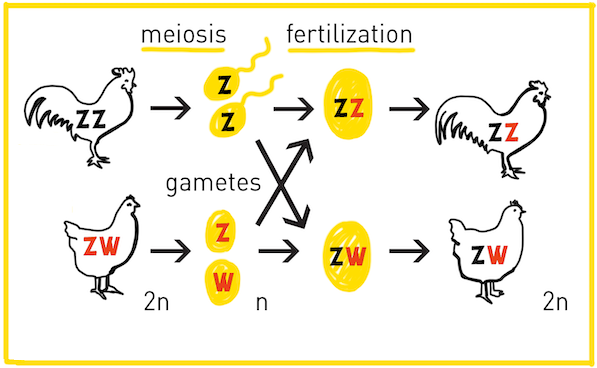
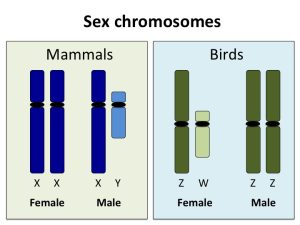 In the same way that the X chromosome is significantly larger than the Y, the Z chromosome is larger than the W. And in the same way that there are alleles that are carried on the X chromosome that aren’t carried on the Y, there are alleles on the Z chromosome that aren’t on the W chromosome. These alleles on the Z chromosome are (like alleles on the X chromosome) called sex-linked alleles.
In the same way that the X chromosome is significantly larger than the Y, the Z chromosome is larger than the W. And in the same way that there are alleles that are carried on the X chromosome that aren’t carried on the Y, there are alleles on the Z chromosome that aren’t on the W chromosome. These alleles on the Z chromosome are (like alleles on the X chromosome) called sex-linked alleles.
Knowing that, try to solve a few problems that involve sex-linked alleles in birds. All of these problems are based on the same scenario.
Domestic chickens have been bred for many years to increase the number of eggs laid by the females. Chick breeders need to be able to identify female chicks on the day after hatching, as only the females need to be kept for laying eggs.
Some genes for feather color and pattern in chickens are carried on the Z chromosome but not on the W chromosome. One such example is the gene for striped feathers (barring).
The phenotypes associated with the two alleles of the barring gene are shown in the table below
| Allele | Adult Phenotype | Day old chick phenotype |
| B | Barred (black feathers striped with white bars) | Black body with a white spot on the head |
| b | Non-barred (black feathers) | Black body and head |
5.1. Sex Linkage Problems in Birds
[qwiz qrecord_id=”sciencemusicvideosMeister1961-Sex-linkage Problems in Birds, APBVP”]
[h]Sex-linkage Problems in Birds
[i]
[q]In chickens, “B” is the allele that causes the “Barred” phenotype. An individual with genotype ZBZb will, as an adult, have which phenotype?
[c]IEJhcnJl ZCBtYWxl[Qq]
[f]IEV4Y2VsbGVudC4gQW4gaW5kaXZpZHVhbCB3aXRoIGdlbm90eXBlIA==Wg==Qg==Wg==Yg==[Qq] will be a barred male (ZZ = male, and B is the allele for barring)
[c]IEJhcnJlZCBmZW1hbGU=[Qq]
[f]IE5vLiBKdXN0IGxvb2sgYXQgdGhlIHByb2JsZW0gYW5kIGFzayB5b3Vyc2VsZiB0d28gcXVlc3Rpb25zLiBGaXJzdGx5LCB3aGF0IGNocm9tb3NvbWFsIGNvbWJpbmF0aW9ucyBhcmUgYXNzb2NpYXRlZCB3aXRoIHdoaWNoIHNleD8gSW4gb3RoZXIgd29yZHMsIFhZIG1ha2VzIGFuIGluZGl2aWR1YWwgbWFtbWFsIG1hbGUsIGFuZCBYWCBtYWtlcyBmZW1hbGVzLiBXaGF0JiM4MjE3O3MgdGhlIHBhcmFsbGVsIGluIGJpcmRzPyBTZWNvbmRseSwgaXMgdGhlIGJhcnJpbmcgYWxsZWxlIGRvbWluYW50IG9yIHJlY2Vzc2l2ZT8gUHV0IHRob3NlIHRvZ2V0aGVyLCBob2xkIGl0IGluIG1lbW9yeSwgYW5kIHlvdSYjODIxNztsbCBnZXQgdGhpcyBxdWVzdGlvbiByaWdodCBuZXh0IHRpbWUu[Qq]
[c]IE5vbi1iYXJyZWQgZmVtYWxl[Qq]
[f]IE5vLiBKdXN0IGxvb2sgYXQgdGhlIHByb2JsZW0gYW5kIGFzayB5b3Vyc2VsZiB0d28gcXVlc3Rpb25zLiBGaXJzdGx5LCB3aGF0IGNocm9tb3NvbWFsIGNvbWJpbmF0aW9ucyBhcmUgYXNzb2NpYXRlZCB3aXRoIHdoaWNoIHNleD8gSW4gb3RoZXIgd29yZHMsIFhZIG1ha2VzIGFuIGluZGl2aWR1YWwgbWFtbWFsIG1hbGUsIGFuZCBYWCBtYWtlcyBmZW1hbGVzLiBXaGF0JiM4MjE3O3MgdGhlIHBhcmFsbGVsIGluIGJpcmRzPyBTZWNvbmRseSwgaXMgdGhlIGJhcnJpbmcgYWxsZWxlIGRvbWluYW50IG9yIHJlY2Vzc2l2ZT8gUHV0IHRob3NlIHRvZ2V0aGVyLCBob2xkIGl0IGluIG1lbW9yeSwgYW5kIHlvdSYjODIxNztsbCBnZXQgdGhpcyBxdWVzdGlvbiByaWdodCBuZXh0IHRpbWUu[Qq]
[c]IE5vbi1iYXJyZWQgbWFsZQ==[Qq]
[f]IE5vLiBKdXN0IGxvb2sgYXQgdGhlIHByb2JsZW0gYW5kIGFzayB5b3Vyc2VsZiB0d28gcXVlc3Rpb25zLiBGaXJzdGx5LCB3aGF0IGNocm9tb3NvbWFsIGNvbWJpbmF0aW9ucyBhcmUgYXNzb2NpYXRlZCB3aXRoIHdoaWNoIHNleD8gSW4gb3RoZXIgd29yZHMsIFhZIG1ha2VzIGFuIGluZGl2aWR1YWwgbWFtbWFsIG1hbGUsIGFuZCBYWCBtYWtlcyBmZW1hbGVzLiBXaGF0JiM4MjE3O3MgdGhlIHBhcmFsbGVsIGluIGJpcmRzPyBTZWNvbmRseSwgaXMgdGhlIGJhcnJpbmcgYWxsZWxlIGRvbWluYW50IG9yIHJlY2Vzc2l2ZT8gUHV0IHRob3NlIHRvZ2V0aGVyLCBob2xkIGl0IGluIG1lbW9yeSwgYW5kIHlvdSYjODIxNztsbCBnZXQgdGhpcyBxdWVzdGlvbiByaWdodCBuZXh0IHRpbWUu[Qq]
[q json=”true” xx=”1″ multiple_choice=”true” unit=”5.Heredity” dataset_id=”2019 AP Bio Dataset|22bbf7a863f45a” question_number=”29″ topic=”5.4.Non-Mendelian_Genetics”] An individual with genotype ZBW will, as an adult, have which phenotype?
[c]IEJhcnJlZCBtYWxl[Qq]
[f]IE5vLiBKdXN0IGxvb2sgYXQgdGhlIHByb2JsZW0gYW5kIGFzayB5b3Vyc2VsZiB0d28gcXVlc3Rpb25zLiBGaXJzdCwgd2hhdCBjaHJvbW9zb21hbCBjb21iaW5hdGlvbnMgYXJlIGFzc29jaWF0ZWQgd2l0aCB3aGljaCBzZXg/IEluIG90aGVyIHdvcmRzLCBYWSBtYWtlcyBhbiBpbmRpdmlkdWFsIG1hbW1hbCBtYWxlLCBhbmQgWFggbWFrZXMgZmVtYWxlcy4gV2hhdCYjODIxNztzIHRoZSBwYXJhbGxlbCBpbiBiaXJkcz8gU2Vjb25kLCBpcyB0aGUgYmFycmluZyBhbGxlbGUgZG9taW5hbnQgb3IgcmVjZXNzaXZlPyBQdXQgdGhvc2UgdG9nZXRoZXIsIGhvbGQgaXQgaW4gbWVtb3J5LCBhbmQgeW91JiM4MjE3O2xsIGdldCB0aGlzIHF1ZXN0aW9uIHJpZ2h0IG5leHQgdGltZS4=[Qq]
[c]IEJhcnJlZC BmZW1hbGU=[Qq]
[f]IFRlcnJpZmljLiBZb3UmIzgyMTc7cmUgY2xlYXJseSB1bmRlcnN0YW5kaW5nIGhvdyBzZXggZGV0ZXJtaW5hdGlvbiBhbmQgc2V4LWxpbmtlZCBhbGxlbGVzIHdvcmsgaW4gYmlyZHMh[Qq]
[c]IE5vbi1iYXJyZWQgZmVtYWxl[Qq]
[f]IE5vLiBKdXN0IGxvb2sgYXQgdGhlIHByb2JsZW0gYW5kIGFzayB5b3Vyc2VsZiB0d28gcXVlc3Rpb25zLiBGaXJzdCwgd2hhdCBjaHJvbW9zb21hbCBjb21iaW5hdGlvbnMgYXJlIGFzc29jaWF0ZWQgd2l0aCB3aGljaCBzZXg/IEluIG90aGVyIHdvcmRzLCBYWSBtYWtlcyBhbiBpbmRpdmlkdWFsIG1hbW1hbCBtYWxlLCBhbmQgWFggbWFrZXMgZmVtYWxlcy4gV2hhdCYjODIxNztzIHRoZSBwYXJhbGxlbCBpbiBiaXJkcz8gU2Vjb25kLCBpcyB0aGUgYmFycmluZyBhbGxlbGUgZG9taW5hbnQgb3IgcmVjZXNzaXZlPyBQdXQgdGhvc2UgdG9nZXRoZXIsIGhvbGQgaXQgaW4gbWVtb3J5LCBhbmQgeW91JiM4MjE3O2xsIGdldCB0aGlzIHF1ZXN0aW9uIHJpZ2h0IG5leHQgdGltZS4=[Qq]
[c]IE5vbi1iYXJyZWQgbWFsZQ==[Qq]
[f]IE5vLiBKdXN0IGxvb2sgYXQgdGhlIHByb2JsZW0gYW5kIGFzayB5b3Vyc2VsZiB0d28gcXVlc3Rpb25zLiBGaXJzdGx5LCB3aGF0IGNocm9tb3NvbWFsIGNvbWJpbmF0aW9ucyBhcmUgYXNzb2NpYXRlZCB3aXRoIHdoaWNoIHNleD8gSW4gb3RoZXIgd29yZHMsIFhZIG1ha2VzIGFuIGluZGl2aWR1YWwgbWFtbWFsIG1hbGUsIGFuZCBYWCBtYWtlcyBmZW1hbGVzLiBXaGF0JiM4MjE3O3MgdGhlIHBhcmFsbGVsIGluIGJpcmRzPyBTZWNvbmRseSwgaXMgdGhlIGJhcnJpbmcgYWxsZWxlIGRvbWluYW50IG9yIHJlY2Vzc2l2ZT8gUHV0IHRob3NlIHRvZ2V0aGVyLCBob2xkIGl0IGluIG1lbW9yeSwgYW5kIHlvdSYjODIxNztsbCBnZXQgdGhpcyBxdWVzdGlvbiByaWdodCBuZXh0IHRpbWUu[Qq]
[q json=”true” xx=”1″ multiple_choice=”true” unit=”5.Heredity” dataset_id=”2019 AP Bio Dataset|22b874ee762c5a” question_number=”30″ topic=”5.4.Non-Mendelian_Genetics”]In a cross between a barred female and a non-barred male, what percentage of the offspring will be non-barred females?
[c]IDAl[Qq]
[f]IE5vLiBZb3UgaGF2ZSB0byB0cmVhdCB0aGlzIGxpa2UgYW55IGdlbmV0aWNzIHByb2JsZW0gdGhhdCBpbnZvbHZlcyBzZXggbGlua2FnZS4gSGVyZSBhcmUgdGhlIGdlbm90eXBlczogdGhlIGJhcnJlZCBmZW1hbGUgaXMgWg==Qg==[Qq]W. The non-barred male is ZbZb. Get a pencil, set up a Punnett square like the one below, and solve the problem (determining the proportion of each phenotype).
| ZB | W | |
| Zb | ||
| Zb |
Hold on to the answer until the next time you see the question.
[c]IDI1JQ==[Qq]
[f]IE5vLiBZb3UgaGF2ZSB0byB0cmVhdCB0aGlzIGxpa2UgYW55IGdlbmV0aWNzIHByb2JsZW0gdGhhdCBpbnZvbHZlcyBzZXggbGlua2FnZS4gSGVyZSBhcmUgdGhlIGdlbm90eXBlczogdGhlIGJhcnJlZCBmZW1hbGUgaXMgWg==Qg==[Qq]W. The non-barred male is ZbZb. Get a pencil, set up a Punnett square like the one below, and solve the problem (determining the proportion of each phenotype).
| ZB | W | |
| Zb | ||
| Zb |
Hold on to the answer until the next time you see the question.
[c]IDUw JQ==[Qq]
[f]IFlvdSYjODIxNztyZSBleGhpYml0aW5nIG1hcnZlbG91cyBtYXN0ZXJ5IG9mIChwb3N0KSBNZW5kZWxpYW4gZ2VuZXRpY3MhIDUwJSBvZiB0aGUgb2Zmc3ByaW5nIGFyZSBub24tYmFycmVkIGZlbWFsZXMuIElmIHlvdSYjODIxNztyZSBsaWtlIG1lLCB5b3Ugc2V0IHVwIHRoaXMgY3Jvc3MuIEFsbCB0aGUgZmVtYWxlcyBhcmUgbm9uLWJhcnJlZCAoWg==Yg==[Qq]W), and that’s 50% of the offspring.
| ZB | W | |
| Zb | ZBZb | ZbW |
| Zb | ZBZb | ZbW |
[c]IDc1JQ==[Qq]
[f]IE5vLiBZb3UgaGF2ZSB0byB0cmVhdCB0aGlzIGxpa2UgYW55IGdlbmV0aWNzIHByb2JsZW0gdGhhdCBpbnZvbHZlcyBzZXggbGlua2FnZS4gSGVyZSBhcmUgdGhlIGdlbm90eXBlczogdGhlIGJhcnJlZCBmZW1hbGUgaXMgWg==Qg==[Qq]W. The non-barred male is ZbZb. Get a pencil, set up a Punnett square like the one below, and solve the problem (determining the proportion of each phenotype).
| ZB | W | |
| Zb | ||
| Zb |
Hold on to the answer until the next time you see the question.
[c]IDEwMCU=[Qq]
[f]IE5vLiBZb3UgaGF2ZSB0byB0cmVhdCB0aGlzIGxpa2UgYW55IGdlbmV0aWNzIHByb2JsZW0gdGhhdCBpbnZvbHZlcyBzZXggbGlua2FnZS4gSGVyZSBhcmUgdGhlIGdlbm90eXBlczogdGhlIGJhcnJlZCBmZW1hbGUgaXMgWg==Qg==[Qq]W. The non-barred male is ZbZb. Get a pencil, set up a Punnett square like the one below, and solve the problem (determining the proportion of each phenotype).
| ZB | W | |
| Zb | ||
| Zb |
Hold on to the answer until the next time you see the question.
[x][restart]
[/qwiz]
What’s Next?
Proceed to the next tutorial: Mitochondrial Inheritance, Incomplete Dominance, and Environment Phenotype Interactions
